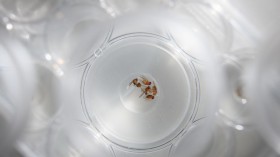A fish head was consumed by a huge, horrifying monster that resembled a deep-sea louse. The unsettling video was taken during a research dive off the coast of Florida.
The video was included in the "31 Dives of Halloween" online series from the NOAA (National Oceanic and Atmospheric Administration) Office of Ocean Exploration and Research, which highlights a variety of unique deep-sea species in the lead-up to the well-known holiday.
Caught on Cam
Giant, horrid deep-sea louse-like creature filmed feasting on fish head https://t.co/3ungz6YoYV
— Newsweek (@Newsweek) October 22, 2022
According to Newsweek, the animal seen in the video is an enormous isopod of the species Bathynomus giganteus, a deep-sea scavenger related to sowbugs and pill bugs often seen in gardens and houses.
Over 10,000 species of isopods, a type of crustacean, exist around the globe. They may be found both on land and in the water.
Also Read: Scientists Mystified After Spotting 'Alien-Like' Blue Goo in the Depths of Caribbean
Giant Isopods
The giant isopod species Bathynomus giganteus, a deep-sea scavenger related to sowbugs and pill bugs frequently observed in gardens and homes, is the creature visible in the video.
According to Stephanie Farrington, giant isopods are an example of deep-sea gigantism, in which deep-sea organisms grow too enormous. She served as the expedition's biology research lead and is currently employed by NOAA Fisheries.
Colder water also correlates with bigger body size-typically, the temperature of the bottom of the ocean is near freezing-so food shortage in the deep sea may have contributed to the evolution of gigantism, according to Farrington, a specialist in deep-sea biology.
The video was recorded in 2019 during a NOAA research mission at a depth of roughly 4,000 feet, some 40 miles southeast of Key West, Florida. It depicts a massive isopod, which is said to be around 8 inches long, munching on a piece of fish.
Although enormous isopods were first identified in 1879, considerable research on them has not yet been done; therefore, many aspects of their biology and behavior are still unknown. This is why scholars value movies like this one so highly.
They are challenging to study since they reside at such deep depths, and up until recent times, the only method of accessing them was by trawls, according to Farrington. Since deep submergence vehicles and contemporary ocean exploration have made it possible to watch gigantic isopods in their native habitat, it has become possible to study their activity more regularly.
Scientists continuously discover new information about these groups of creatures despite having a fundamental grasp of their nutrition, breeding practices, and distribution. This year, a new species from the Gulf of Mexico was described.
Giant isopods have an exoskeleton, which is a hard shell similar to that of all crustaceans. According to Farrington, these extraterrestrial beings had three body parts: the cephalon (head), pereon (thorax), and pleon (abdomen).
They have two sets of antennae-one long pair and one small pair-14 jointed legs, and a uropod, a fanned tail. Pleopods, a group of peculiar appendages on their abdomen, is a component of their breathing system.
Looking at the Deep-Sea Creatures
According to Farrington, giant isopods have been found or collected at depths between 170 and 2,140 meters (558 and 7,020 feet) worldwide. Bathynomus giganteus is mostly found on or close to the sandy bottom in the Gulf of Mexico, the Straits of Florida, and as far south as Brazil.
According to evidence from the fossil record, giant isopods have lived for more than 160 million years.
These species may unintentionally be trapped by deep-sea trawlers and are also exposed to plastic contamination.
Related Article: 'Zombie Worms' Feeding on Skeletons of Whales Discovered Deep Under the Sea
For more news from the animal kingdom, don't forget to follow Nature World News!
© 2024 NatureWorldNews.com All rights reserved. Do not reproduce without permission.





